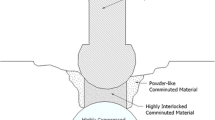Abstract
A finite-element model of the cold compaction of ceramic powders by uniaxial pressing is developed and validated by comparison with experimental data. The mechanical behavior of processing powders is assumed according to the modified Drucker-Prager cap model. The frictional effects and the mechanical behavior of tools involved in the process are taken into account. The proposed model allows evaluation of the density distribution into the processed part, as well as stress and strain fields. Variations of the density distribution due to the unloading and the ejection of the part are evaluated
Similar content being viewed by others
References
A. N. Guz, “On foundation of non-destructive method of determination of three-axial stresses in solids,” Int. Appl. Mech., 37, No. 7, 899–905 (2001).
A. N. Guz and F. G. Makhort, “The physical fundamentals of the ultrasonic nondestructive stress analysis of solids,” Int. Appl. Mech., 36, No. 9, 1119–1149 (2000).
J. J. Rushchitsky, C. Cattani, and E. V. Terletskaya, “Wavelet analysis of the evolution of a solitary wave in composite material,” Int. Appl. Mech., 40, No. 3, 311–318 (2004).
C. Cattani, J. J. Rushchitsky, and S. V. Sinchilo, “Comparative analysis of the profile evolutions of an elastic harmonic wave caused by the second and third harmonics,” Int. Appl. Mech., 40, No. 2, 183–189 (2004).
C. Cattani and J. J. Rushchitsky, “Plane waves in cubically nonlinear elastic media,” Int. Appl. Mech., 38, No. 11, 1361–1365 (2002).
C. Cattani and J. J. Rushchitsky, “Cubically nonlinear versus quadratically nonlinear elastic waves: Main wave effects,” Int. Appl. Mech., 39, No. 12, 1361–1399 (2003).
J. J. Rushchitsky, C. Cattani, and E. V. Terletskaya, “Wavelet analysis of a single pulse in a linearly elastic composite,” Int. Appl. Mech., 41, No. 4, 374–380 (2005).
I. Aydin, B. J. Briscoe, and K. Y. Şanlitürk, “The internal form of compacted ceramic components: a comparison of a finite element modelling with experiment,” Powder Tech., 89, 239–254 (1996).
A. Bejarano, M. D. Riera, and J. M. Prado, “Simulation of the compaction process of a two-level powder metallurgical part,” J. Mater. Proc. Tech., 143–144, 34–40 (2003).
H. Chtourou, M. Guillot, and A. Gakwaya, “Modeling of the metal powder compaction process using the cap model. Part I. Experimental material characterization and validation,” Int. J. Solids Struct., 39, 1059–1075 (2002).
H. Chtourou, M. Guillot, and A. Gakwaya, “Modeling of the metal powder compaction process using the cap model. Part II. Numerical implementation and practical application,” Int. J. Solids Struct., 39, 1077–1096 (2002).
S. C. Lee and K. T. Kim, “Densification behavior of aluminum alloy powder under cold compaction,” Int. J. Mech. Sci., 44, 1295–1308 (2002).
R. W. Lewis and A. R. Khoei, “Numerical modelling of large deformation in metal powder forming,” Comp. Math. Appl. Mech. Eng., 159, 291–328 (1998).
D. H. Zeuch, J. M. Grazier, J. R. Argüello, and K. G. Ewsuk, “Mechanical properties and shear failure surfaces for two alumina powders in triaxial compression,” J. Mater. Sci., 36, 2911–2924 (2001).
I. C. Sinka, J. C. Cunningham, and A. Zavaliangos, “The effect of wall friction in the compaction of pharmaceutical tablets with curved faces: A validation study of the Drucker-Prager cap model,” Powder Technology, 133, 33–43 (2003).
A. Michrafy, D. Ringenbacher, and P. Tchoreloff, “Modelling the compaction behavior of powders: Application to pharmaceutical powders,” Powder Technology, 127, 257–266 (2002).
N. A. Fleck, L. T. Kuhn, and R. M. McMeeking, “Yielding of metal powder bonded by isolated contacts,” J. Mech. Phys. Solids, 40, 1139–1162 (1992).
L. T. Kuhn and R. M. McMeeking, “Power law creep of powder bonded by isolated contacts,” J. Mech. Phys. Solids, 34, 563–573 (1992).
O. Skrinjar and P. L. Larsson, “Cold compaction of composite powders with size ratio,” Acta Materialia, 52, 1871–1884 (2004).
L. P. Khoroshun and D. V. Babich, “Stability of plates made of a granular composite with damageable components,” Int. Appl. Mech., 40, No. 7, 803–809 (2004).
S. D. Akbarov and A. N. Guz, “Continuum approaches in the mechanics of curved composites and associated problems for structural members,” Int. Appl. Mech., 38, No. 11, 1285–1308 (2002).
S. D. Akbarov and A. N. Guz, “Mechanics of curved composites (piecewise-homogeneous body model),” Int. Appl. Mech., 38, No. 12, 1415–1439 (2002).
R. W. Lewis and A. R. Khoei, “A plasticity model for metal powder forming processes,” Int. J. Plasticity, 17, 1659–1692 (2001).
C. Gu, M. Kim, and L. Anand, “Constitutive equation for metal powders: application to powder forming processes,” Int. J. Plasticity, 17, 147–209 (2001).
A. F. Bulat, “Rock deformation problems,” Int. Appl. Mech., 40, No. 12, 1311–1322 (2004).
A. R. Khoei and A. R. Azami, “A single cone-cap plasticity with an isotropic hardening rule for powder materials,” Int. J. Mech. Sci., 47, 94–109 (2005).
F. L. DiMaggio and I. S. Sandler, “Material models for granular soils,” J. Eng. Mech. Divis. ASCE, 935–950 (1971).
D. D. Ivlev, “Perfect plasticity theory: State of the art and development trends,” Int. Appl. Mech., 39, No. 11, 1241–1270 (2003).
Author information
Authors and Affiliations
Additional information
Published in Prikladnaya Mekhanika, Vol. 42, No. 10, pp. 135–143, October 2006.
Rights and permissions
About this article
Cite this article
Carlone, P., Palazzo, G.S. Computational modeling of the cold compaction of ceramic powders. Int Appl Mech 42, 1195–1201 (2006). https://doi.org/10.1007/s10778-006-0191-z
Received:
Issue Date:
DOI: https://doi.org/10.1007/s10778-006-0191-z




